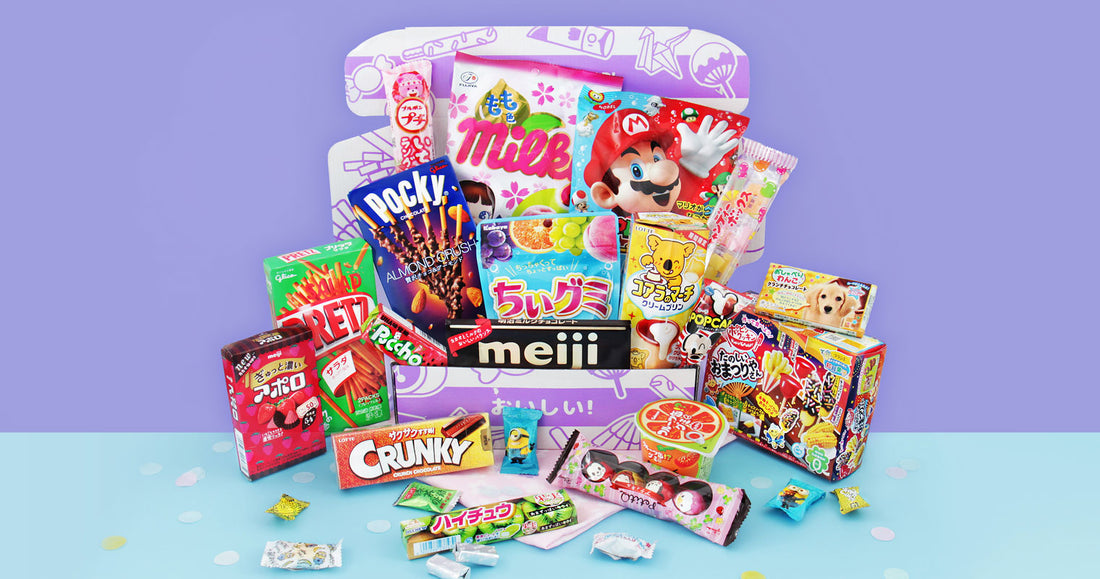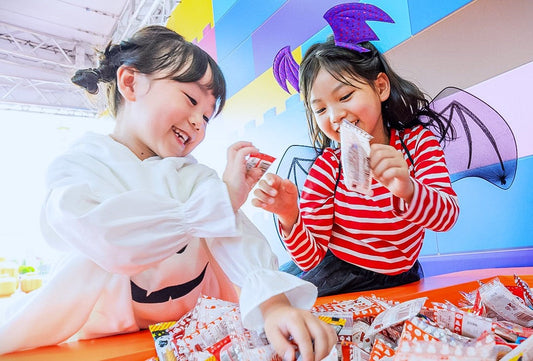In Japan, summer can be a little bit daunting. Temperatures can rocket to 30°C (86°F) and sometimes even reach 40°C (104°F) in some places in the country. Add a ton of humidity, and the summer weather of Japan makes people feel like they're swimming in warm miso soup. Despite the atrocious combination of excessive heat and humidity, summer in Japan is still worth experiencing with its outdoor adventures, colorful festivals, and most especially, its tasty assortment of Japanese summer treats!
Let's jump right in!
- Japanese Festival Foods
- Japanese Watermelon
- Morioka Reimen Noodles
- Cold Somen Noodles
- Nagashi Somen Noodles
- Hiyashi Chuka Noodles
- Hiyayakko Tofu
- Mizu Yokan Jelly
- Konbini Ice Cream
- Kakigori

Japan loves cooling down from the inside out; that’s why Japanese summer snacks are always so light and refreshing. Grab your chopsticks and get ready because we’re going on a culinary expedition to learn about the tastiest Japanese snacks during summer!
10. Japanese Festival Foods

In Japan, summer is filled with festivals called Natsu Matsuri, where people mix together traditional performances, firework displays, and a lot of fun games. There’s also a ton of stalls offering tasty festival food to munch on while you walk around the festival grounds. Considered light Japanese snacks, festival foods are delicious and easy to eat!
Some of the yummy staples at festivals include yakisoba (fried noodles), takoyaki (octopus balls), okonomiyaki (savory pancakes), ringo ame (candied apples) and dango (skewered rice balls). Of course, there are a few unique offerings depending on the festival and the region, like ika-menchi (squid patty), which can only be found in festivals in the Tohoku region. If you’d like to learn more about all the yummiest Japanese festival foods, you can head over to our blog, The 25 Best Japanese Festival Food Ever.
9. Japanese Watermelon

Watermelon might seem a little bit ordinary, but on hot days, Japanese people love having watermelon slices to cool down the heat. In Japanese dramas and anime shows, you'll often get to see people relaxing during the summer by nibbling on some refreshing watermelon. If you visit Japan during the sunny season of summer, you might even get to spot people playing suika-wari, a fun little game where someone is blindfolded and then instructed to smash a watermelon with a stick.

Japanese watermelons are sweeter than watermelons from other countries. That's because farmers grow them in the best conditions that they can - they choose the perfect soil, the perfect seeds, and they do the perfect pruning. One of the sweetest watermelons in Japan are the black watermelons from the town of Toma in Hokkaido. They're extra sweet and delicious!

Special watermelons are also given as summer gifts among households. Most of the time, these watermelons come shaped as squares. They're grown into the shape of a cube so they fit perfectly into a refrigerator. Sometimes, though, gift watermelons can come in other shapes and sizes, such as pyramids and hearts.
8. Morioka Reimen Noodles

Hailing from the Iwate Prefecture, Morioka reimen is a type of cold ramen with refreshing summer vegetables added to it. Created from a North Korean dish, its soup is made of cool beef broth, it has slippery Japanese noodles, and its toppings are usually made of summery vegetables like carrot, cucumber, tomato, and kimchi. It also has fruits like watermelon and pear!
Morioka reimen is light and refreshing - the perfect summer dish. Without the oiliness and heavy broth of normal ramen, Morioka reimen is considered a healthy option for someone trying to diet during the summer. Though the best Morioka reimen can be found in Morioka City itself, you can also find shops in Tokyo selling these summer noodles.
7. Cold Somen Noodles

Somen are thin, white Japanese noodles made of wheat flour. With a thickness of 1.3mm, somen is the thinnest noodle in Japan. It has a light and neutral flavor that goes perfectly with its delicious dipping sauce. It might sound strange to have cold noodles, but somen is a summer dish that's always served chilled!

Though you can eat somen noodles on their own with special mentsuyu dipping sauce(made of dashi, soup stock, soy sauce, and mirin), somen can also be paired with refreshing vegetables like shiso leaves, myoga (Japanese ginger), green onion, and regular grated ginger.
6. Nagashi Somen Noodles

This might be one of the most entertaining summer dishes in Japan! Like you’d expect, nagashi somen uses somen noodles just like cold somen. The only difference this time is how they’re served! Nagashi is the Japanese word for flow, and these noodles are served free-flowing on bamboo slides for customers to scoop up with their chopsticks.
Once you pluck out the nagashi noodles from the water, you dip your catch in tsuyu, a cool soy sauce-based dipping broth. There are a lot of noodles to go around, and they're always served in bite-sized portions, so you can relax the summer afternoon away eating noodles while chatting with friends! Though Nagashi somen is usually found in Kyoto, you can also find some restaurants serving it in Tokyo.
5. Hiyashi Chuka Noodles

Another type of cold noodle, Hiyashi Chuka, is a Chinese-style dish made of chilled Chinese noodles topped with slices of eggs and summer vegetables like tomatoes, cucumber, and bean sprouts. It's drowned in a cold sauce made of sesame, shoyu, and dashi.
Some people like to think of hiyashi chuka as a chilled ramen that's close to a salad. That's because even though people usually use summer vegetables to top hiyashi chuka, this cold noodle is pretty flexible, where you can customize the toppings as much as you'd like.
4. Hiyayakko Tofu

Sometimes you need something as simple and as healthy as tofu for the summer. A cold tofu dish made of yakko dofu (a special kind of tofu), hiyayakko, is a favorite dish at izakayas in Japan. It helps lighten the taste of meals with lots of deep-fried food.

A simple dish, this tofu is topped with spring onions, katsuobushi fish flakes, grated ginger, and a dash of soy sauce. You can also customize hiyayako according to your taste by adding other toppings like ham, cucumber, shiso leaf, tomato, wakame, or even wasabi!
3. Mizu Yokan Jelly

This is one of the desserts that the Japanese love to eat during the summer. Yokan is a jelly-like wagashi or traditional Japanese dessert made from red bean paste, walnuts, sugar, and agar. During the summer, the Japanese add more water to the yokan to make it softer and lighter.
Slippery and fresh in your mouth, mizu yokan quenches the thirst that you feel on a hot sunny day. While Mizu Yokan is traditionally mixed with chopped chestnuts to add to its texture, you can also add some other ingredients like sweet potato and bits of fruit. One of the most popular flavor additions to mizu yokan is matcha!
2. Konbini Ice Cream

Nothing beats the heat better than a bit of ice cream. Luckily, Japan’s konbinis (convenience stores) have a great selection of ice cream bars and popsicles to choose from. There’s Japanese Häagen-Dazs, which releases special seasonal flavors. During the summer, you'll find limited-edition flavors like Summer Blueberry & Lemon, Rich Peach, Passion Fruit & Sweet Pear, and so much more.

You’ll also find the ice-cream version of Japanese chocolates like Dars and even ice cream versions of Japanese snacks like Jumbo Monaka. The Jumbo Monaka ice cream is pretty filling since it’s more of an ice cream sandwich with a slab of chocolate to go along with it. If you'd like something more bite-sized, then you can grab a box of Pino - chocolate-covered ice cream bits that come with a small toothpick so you can eat fuss-free!
Another konbini freezer staple is Shirokuma. This treat really isn't ice cream but shaved ice with a rich milk flavor. Shirokuma cups usually come with colorful fruit toppings to add to the crumbly texture of your shaved ice treat. If you're looking for a Japanese ice cream bar, you won't go wrong with Gari Gari Kun. It's rich and yet refreshing at the same time!
Discover unique Japanese snacks and candies from the konbini! Japan Candy Box delivers the tastiest konbini treats straight from Japan to your doorstep.
1. Kakigori

Kakigori is the ultimate summer treat in Japan! Translating into "shaved ice" in English, kakigori is a sweet ice treat made of, you guessed it, finely-shaved ice bits, syrups, flavorings, and toppings. Though some people might compare it to shaved ice in the US, kakigori has a much, much finer texture and the topping selection is so much better with things like adzuki beans, fruits, cheese, and so much more.

In Japan, there are tons of shops that specialize in kakigori. You can also find smaller cups of kakigori being served at stands during summer festivals or matsuri! Have fun discovering unique kakigori flavors like green melon, uji matcha, avocado, and fig. Sometimes shops even offer fried and alcoholic kakigori for a unique summer experience!
Bonus: Ramune Drinks and Candy

Ramune is a fun and fizzy carbonated soft drink from Japan. It's light and refreshing, and it's super popular during summer! A bubbly soda that tastes a bit like lemonade, ramune is known for its unique bottle. Ramune is kept in a cod-neck bottle with a fun little marble inside that keeps bubbles trapped inside so you always get that satisfying fizzy taste of soda! You'll never have to worry about your ramune getting stale.

Created in the 1880s by a Scottish man living in Japan, ramune is an iconic drink that's been popular for decades. This soda is so popular that there are tons of ramune-flavored Japanese candies and snacks! You can enjoy the fizz of ramune hard candies, chew on refreshing ramune gummies, and even nibble on ramune-flavored treats like cream sandwiches and caramel corn puffs.

Well, there you have it. These are our top 10 Japanese snacks and sweets that you’ll have to try during the summer (plus a little bonus treat because who doesn’t want a little extra yummy in their tummy, right?).

Which treat are you interested in the most? Are you into the idea of eating nagashi somen from bamboo slides? Would you like to pick out ice cream from Japanese konbinis? Or would you rather nibble on Japanese festival foods while walking around matsuri grounds? Don’t be shy, let us know in the comment section below. We’d love to talk about yummy Japanese treats with you!







